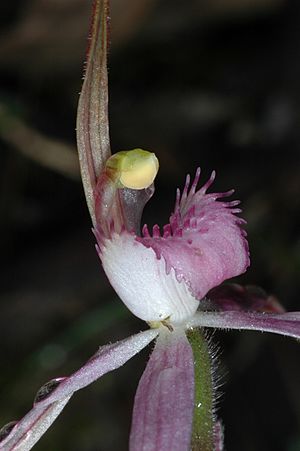Rosella spider orchid facts for kids
Quick facts for kids Rosella spider orchid |
|
|---|---|
 |
|
| Caladenia rosella growing near Cottles Bridge, Victoria | |
| Conservation status | |
| Scientific classification | |
| Genus: |
Caladenia
|
| Species: |
rosella
|
| Synonyms | |
|
Arachnorchis rosella (G.W.Carr) D.L.Jones & M.A.Clem. |
|
The Rosella spider orchid (scientific name: Caladenia rosella) is a special type of plant. It belongs to the orchid family. This beautiful orchid grows only in south-eastern Australia. It is a ground orchid, meaning it grows in the soil. Each plant has one hairy leaf and one lovely pink flower. The flower also has a nice scent.
Sadly, there are not many Rosella spider orchids left. In the year 2000, scientists thought there were only about 120 plants. These plants were found in four small groups in Victoria. There was once a record of this orchid in New South Wales. But now, it is considered "extinct" in that state.
What it Looks Like
The Rosella spider orchid is a perennial plant. This means it lives for more than two years. It is also a deciduous plant, so it loses its leaves at certain times. It grows from an underground tuber, which is like a small storage root.
Each orchid has one upright, hairy leaf. This leaf is about 40 to 90 millimeters (1.6 to 3.5 inches) long. It is also about 5 to 8 millimeters (0.2 to 0.3 inches) wide.
A single flower grows on a tall stalk. This stalk is about 100 to 170 millimeters (3.9 to 6.7 inches) high. The flower itself is usually pale or bright pink. It measures about 50 to 60 millimeters (2.0 to 2.4 inches) across. The sepals and petals of the flower have long, dark, thread-like tips. These tips are covered with tiny hairs that produce a sticky substance.
The top sepal stands straight up. It is about 30 to 50 millimeters (1.2 to 2.0 inches) long. The side sepals spread out wide and point slightly downwards. They are also 30 to 50 millimeters long. The petals are arranged like the side sepals. They are about 30 to 40 millimeters (1.2 to 1.6 inches) long.
The labellum is a special part of the orchid flower. It is about 10 to 14 millimeters (0.4 to 0.6 inches) long. It is pale pink near its base and darker pink towards its edges. The sides of the labellum have small, tooth-like parts. There are also four or six rows of pink bumps, called calli, along its center. When the weather is warm, the flowers have a musky smell. These orchids usually bloom from August to September.
Where it Lives
The Rosella spider orchid grows in areas just north of Melbourne. It likes to live in woodlands and low forests. In the past, it was found in more places. It used to grow in central and western Victoria. It was also found in nearby parts of New South Wales.
How it Reproduces
The Rosella spider orchid is mainly pollinated by a type of male wasp called a thynnid wasp. Pollination is how plants make seeds. A small bee from the Neoproctus group has also been seen helping to pollinate this orchid.
Why it Needs Our Help
The number of Rosella spider orchids has gone down a lot. This is because their homes (habitats) have been destroyed or broken up. By the year 2000, only about 120 plants were known. These were in just four small groups near Melbourne.
This orchid is now considered "extinct" in New South Wales. It is also listed as "endangered" by the Australian Government. This means it is at high risk of disappearing forever. The main dangers to the Rosella spider orchid are:
- Weed invasion: Weeds can grow over the orchids and take their space and nutrients.
- Trampling: People walking or playing in their habitat can accidentally step on them.
- Grazing: Rabbits eating the plants can also harm them.


